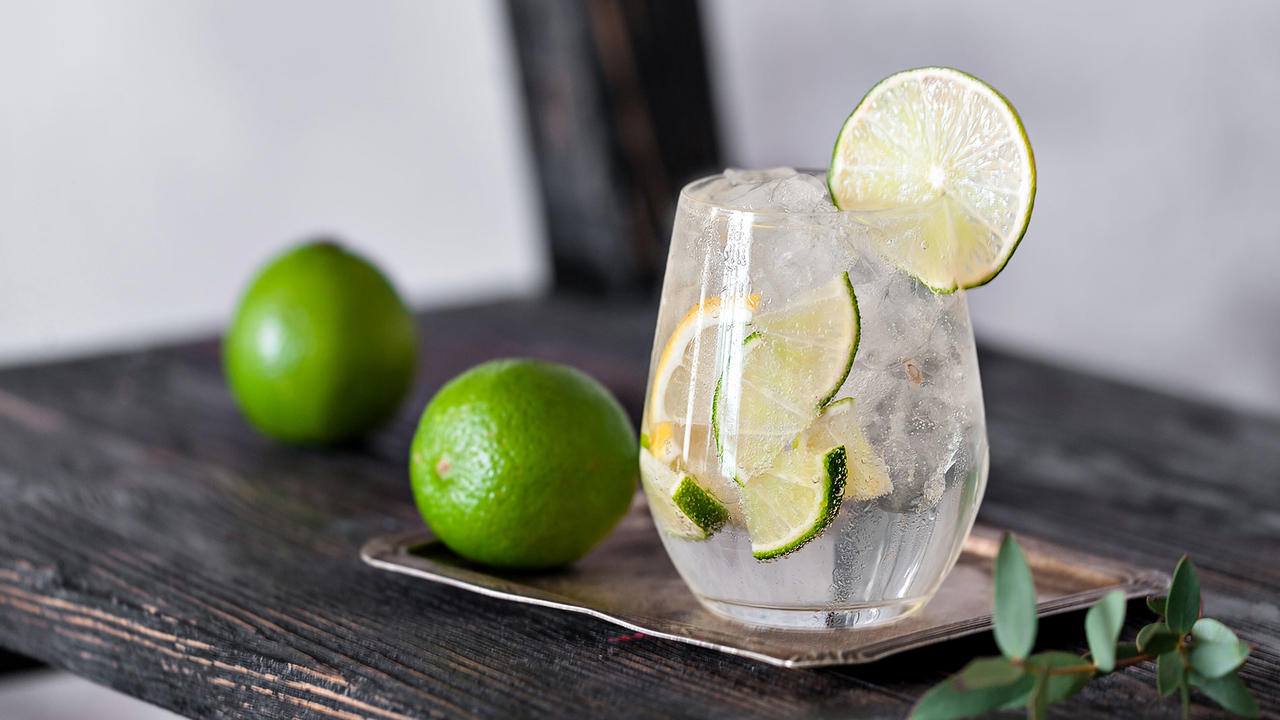Gin is a distilled spirit made from juniper berries and grain. The juniper berries (plus other botanicals) is where gin's iconic flavour derives from. The spirit offers a wide variety of styles and cocktail options, whilst owning a rich, colourful history too.
There's a lot to learn about gin, so let's dive into this botanical drink...
What is gin made from?

Gin is made from a grain, usually wheat or barley. This is the base grain needed to distill gin. This means it's a neutral spirit similar to that of vodka before the botanicals are introduced.
Juniper berries are added later in the process and become the predominant flavour of the spirit. Other botanicals are also added to develop the flavour. This officially classifies it as 'gin'.
Other variations of gin, like pink gin and sloe gin, have added elements like berries or floral ingredients, to dull the juniper notes a little.
How is gin made?

In simple terms, gin is made with juniper berries and a neutral grain alcohol, that's distilled through a process. However, the distillation process is a little more complicated than this and requires some skilled hands. Here's the five step process to making gin...
Step 1 - Boiling
A copper still is filled with a grain neutral spirit and highly purified water. More grain neutral spirit is added than water as the alcohol content must be very high, around 95 percent. This mixture is then left to heat up and create a vapour.
Step 2 - Infusion/Steeping
Distilled gin is either flavoured through infusion or steeping. Infusion means allowing the highly alcoholic vapour to pass through botanicals lying in a basket, gradually infusing the spirit. Steeping means adding the botanical ingredeints into the copper still.
There's no right or wrong way to flavour the gin. The most important part is that the gin is getting that juniper berry flavour.
Step 3 - Cooling
Once the gin mix has been vapourised, and picked up all the added flavours, it's then cooled in the condenser. The cool climate in the condenser chamber allows the gin vapour to condense, where the liquid is caught and stored in another tank.
Step 4 - Collecting
The initial part of the liquid is known as the 'heads'. This has an unwanted flavour and is disposed of. Once this is done, the remaining liquid (the hearts) are collected to form the basis of the gin. So far, this process has taken roughly 3-5 hours, depending on quantity.
Step 5 - Bottling
This high strength gin (the hearts) is cut with purified water, so it reaches the required percentage of alcohol. The gin alcohol percentage is anywhere from 35-55 percent, depending on style. Once this is complete, the distilled gin is ready to be bottled!
Gin botanicals
To be considered the 'real deal', gin must use botanicals during its production. Gin distillers use a whole variety of natural botanicals and ingredients to flavour their gin. Angelica root, citrus peels (like lemon or orange), cassia bark, anise, cloves and cardamom seeds are some of the most popular additions, alongside these two required ingredients...
Juniper berries: Juniper is the main flavour in gin, and is part of the Cypress family of plants. These berries are usually harvested from countries like India, North Macedonia, Italy and Serbia.
Coriander seeds: This is the second most important source for the taste of gin. It's the essential oil in coriander (linalool) that's used to flavour the spirit. Linalool produces a taste of sage, lemon, and ginger. Its aromas are fragrant, spicy, and mellow. The coriander seed comes from countries like Russia, Bulgaria, Moldova, Morocco, and Romania.
What are the types of gin?

There are five different types of gin: London Dry gin, Plymouth gin, Genever, Old Tom gin and New American gin. There is some debate in the gin world about how many types of gin there are and which styles should be included. On average, these are the five types of gin most agree to...
1. London Dry gin
London Dry gin is a style and option that most people who consume gin would consider the original. This English-style of the spirit is heavily infused with a juniper flavour, meaning it's very aromatic and light in body. London Dry gin is infused with a mix of aromatic ingredients usually during a second distillation. Whether it's the classic Martini, Aviation, or the Gin and Tonic, London Dry gin is requested by many as their English gin of choice, based on its reputation of quality.
Best cocktail: Gin and Tonic
2. Plymouth gin
The Plymouth style is a well-known variety, which hails from Plymouth, England (unsurprisingly). This style — infused with many more botanical roots — has a flavour that is much more earthy and less dry compared to the London Dry. If a dry style is what you pine for with a hint more juniper, then Plymouth gin is a popular style to use for making Martinis.
Best cocktail: Martini
3. Genever (Dutch)
The third style of gin is the Genever (Dutch). This style could be named the 'odd-one-out' due to its different colour and taste compared to the other styles like London Dry or Plymouth gin. Genever is arguably where gin started and uses malt as its base grain, not wheat or barley. This makes the drink significantly darker and gives it a whiskey-like flavour. Of course, this isn't a whiskey, but imagine a weak whiskey flavour, mixed with light-bodied botanicals. This is what you should expect!
Best cocktail: The Dutch Apple
4. Old Tom gin
Old Tom gin — a reference to the Tom Collins — is a style that is considered to be a much sweeter version, compared its cousin, the London Dry. Old Tom gin is considered to be a fusion between Genever and London Dry gin in flavour. It's a very smooth gin, so does well in cocktails with many different ingredients.
Best cocktail: Tom Collins, of course.
5. New American (Western Dry)
The Western Dry gin style is the newest on the market, originating from the USA originally. Now produced globally, the New American style of gin was created to try and make inroads into the traditional spirit markets. Its plan was to change the way gin die-hards thought and drank the spirit. Now, many modern gin brands consider themselves to be a Western Dry gin, like Tanqueray and Hendrick's.
Best cocktail: Aviation
We'd like to make an honourable mention to Navy Strength gin as we finish this list. Navy Strength gin is a gin that must have an alcohol percentage of at least 57 percent. Some don't consider this gin to be a 'type of gin' as the only difference is its alcohol percentage, not process or ingredients. We don't want to take sides on this and upset someone, no politics, please!
Fancy getting to grips with the differences between liquor vs liqueur? There are so many gin liqueurs out there but what makes them different? Discover it all here...
The history of gin

The history of gin spans mainly over two nations: The Netherlands and England. In fact, its name derives from the Dutch word for juniper, genever. The 1600s saw an explosion of Genever production in The Netherlands, as this botanical spirit hit the Dutch by storm.
Like so many spirits, gin originated as a medicine. Dutch physician, Farmer John, is often given credit for creating the spirit in the 17th century, as a medicine for dyspepsia. It was later 'jazzed up' with juniper berries by the Dutch to make it more drinkable.
Come the Thirty Years War and its migration over to England had began, as well as its transformation into the gin we know and love today. British soldiers fighting in the Low Countries were given 'Dutch Courage' through drinking this spirit, in an effort to fight off the cold, damp conditions.
Once it hopped across the Channel, its popularity really exploded. The late 1600s saw the King of England enact statutes allowing for gin distillation all over the country, starting 'The Craze'. Reports suggest almost a quarter of Londoners were producing their own gin at the height, causing a pandemic of gin-drunk drinkers spilling onto the streets across the country. This was known as 'The Gin Craze'.
As time went on, Britain refined its relationship with gin and can proudly call themselves the creators of the 'G & T'. The history of Gin and Tonic starts during the British's exploits in India in the 19th century. The British Royal Navy decided to make the malaria medicine (quinine) more palatable. By mixing in some gin, water, sugar and lime, the malaria treatment turned into a delicious cocktail. Once brought back to Britain, the Gin and Tonic was born.
Why is gin so popular? Gin's popularity hasn't faded over time, it's only gotten bigger! There's a whole host of reasons for this gin explosion, some you wouldn't expect...
Gin cocktails

If you decide to drink gin with just tonic water, you're missing out on so many other brilliant flavour combinations. Of course, we wouldn't dare criticise the Gin and Tonic (it's great), but check out these classic gin cocktail recipes too...
- Gin and Tonic
- Martini
- Tom Collins
- Aviation
- Ramos Gin Fizz
- French 75
- Bramble
- Negroni
FAQs: What is gin?

We may not have answered all of your burning gin questions yet (sorry), so we thought we'd add some quick FAQs to finish...
Are vodka and gin the same?
No. Gin is different to vodka. Gin must have the added flavours of juniper to be classed as 'gin'. Other botanicals are also added at the distiller's discretion, making the two spirits different.
Is gin made from vodka?
No. Gin is not made from vodka. However, both spirits can use a neutral base grain mixture initially to start the spirit making process.
What type of alcohol is gin?
Gin is a purified spirit made through a distillation process.
What is sloe gin?
Sloe gin is a type of red gin-based liqueur made from gin and sloe berries. The sloe berries are steeped in the gin for a period of time, before straining and enjoying alongside some tonic water.
What is pink gin?
Pink gin began originally a cocktail, made from gin and Angostura bitters by the British Royal Navy. Nowadays, if you're asking 'what is pink gin?' it's more so gin flavoured with red fruits like strawberries and raspberries. Pink gin is classed as a 'flavoured gin'.
What is gin liqueur?
Gin liqueur is a drink made from distilled gin, flavourings and sugar. Gin liqueurs have a much lower alcohol percentage of around 20-25, than the original gin spirit. The difference between gin and gin liqueur purely lies in the ingredients makeup.
Gin liqueurs are very popular these days with a whole host of potential flavour combinations, like rhubarb and ginger or raspberry.
What's the nutritional value of gin?
Per 42 ml serving of gin there are: 110 calories, 0g fat, 0g carbohydrates, 0g protein, 0g sugar.
Looking for a unique bottle of gin as a gift? This Unicorn Tears Gin is sure to impress and amaze!
Now you know what is a Gin and Tonic, why not start making them behind the bar professionally? Check out our bartender courses to start your amazing journey...

